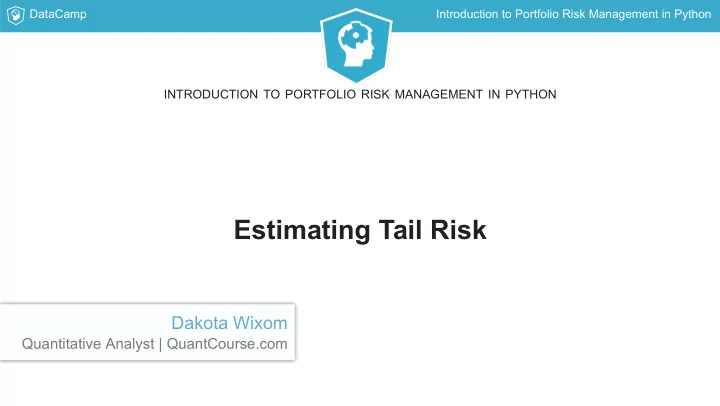

DataCamp Introduction to Portfolio Risk Management in Python INTRODUCTION TO PORTFOLIO RISK MANAGEMENT IN PYTHON Estimating Tail Risk Dakota Wixom Quantitative Analyst | QuantCourse.com
DataCamp Introduction to Portfolio Risk Management in Python Estimating Tail Risk Tail risk is the risk of extreme investment outcomes, most notably on the negative side of a distribution. Historical Drawdown Value at Risk Conditional Value at Risk Monte-Carlo Simulation
DataCamp Introduction to Portfolio Risk Management in Python Historical Drawdown HISTORICAL DRAWDOWN OF Drawdown is the percentage loss from THE USO OIL ETF the highest cumulative historical point. r t Drawdown = − 1 RM r : Cumulative return at time t t RM : Running maximum
DataCamp Introduction to Portfolio Risk Management in Python Historical Drawdown in Python Assuming cum_rets is an np.array of cumulative returns over time In [1]: running_max = np.maximum.accumulate(cum_rets) In [2]: running_max[running_max < 1] = 1 In [3]: drawdown = (cum_rets)/running_max - 1 In [4]: drawdown Out [4]: Date Return 2007-01-03 -0.042636 2007-01-04 -0.081589 2007-01-05 -0.073062
DataCamp Introduction to Portfolio Risk Management in Python Historical Value at Risk Value at Risk , or VaR, is a threshold with a given confidence level that losses will not (or more accurately, will not historically) exceed a certain level. VaR is commonly quoted with quantiles such as 95, 99, and 99.9. Example: VaR(95) = -2.3% 95% certain that losses will not exceed -2.3% in a given day based on historical values.
DataCamp Introduction to Portfolio Risk Management in Python Historical Value at Risk in Python In [1]: var_level = 95 In [2]: var_95 = np.percentile(StockReturns, 100 - var_level) In [3]: var_95 Out [3]: -.023
DataCamp Introduction to Portfolio Risk Management in Python Historical Expected Shortfall Conditional Value at Risk , or CVaR, is an estimate of expected losses sustained in the worst 1 - x% of scenarios. CVaR is commonly quoted with quantiles such as 95, 99, and 99.9. Example: CVaR(95) = -2.5% In the worst 5% of cases, losses were on average exceed -2.5% historically.
DataCamp Introduction to Portfolio Risk Management in Python Historical Expected Shortfall in Python Assuming you have an object StockReturns which is a time series of stock returns. To calculate historical CVaR(95): In [1]: var_level = 95 In [2]: var_95 = np.percentile(StockReturns, 100 - var_level) In [3]: cvar_95 = StockReturns[StockReturns <= var_95].mean() In [3]: cvar_95 Out [3]: -.025
DataCamp Introduction to Portfolio Risk Management in Python INTRODUCTION TO PORTFOLIO RISK MANAGEMENT IN PYTHON Let's practice!
DataCamp Introduction to Portfolio Risk Management in Python INTRODUCTION TO PORTFOLIO RISK MANAGEMENT IN PYTHON VaR Extensions Dakota Wixom Quantitative Analyst | QuantCourse.com
DataCamp Introduction to Portfolio Risk Management in Python VaR Quantiles
DataCamp Introduction to Portfolio Risk Management in Python Empirical Assumptions Empirical Historical values are those that have actually occurred. How do you simulate the probability of a value that has never occured historically before? Sample from a probability distribution
DataCamp Introduction to Portfolio Risk Management in Python Parametric VaR in Python Assuming you have an object StockReturns which is a time series of stock returns. To calculate parametric VaR(95): In [1]: mu = np.mean(StockReturns) In [2]: std = np.std(StockReturns) In [3]: confidence_level = 0.05 In [4]: VaR = norm.ppf(confidence_level, mu, std) In [5]: VaR Out [5]: -0.0235
DataCamp Introduction to Portfolio Risk Management in Python Scaling Risk
DataCamp Introduction to Portfolio Risk Management in Python Scaling Risk in Python Assuming you have a one-day estimate of VaR(95) var_95 . To estimate 5-day VaR(95): In [1]: forecast_days = 5 In [2]: forecast_var95_5day = var_95*np.sqrt(forecast_days) In [3]: forecast_var95_5day Out [3]: -0.0525
DataCamp Introduction to Portfolio Risk Management in Python INTRODUCTION TO PORTFOLIO RISK MANAGEMENT IN PYTHON Let's practice!
DataCamp Introduction to Portfolio Risk Management in Python INTRODUCTION TO PORTFOLIO RISK MANAGEMENT IN PYTHON Random Walks Dakota Wixom Quantitative Analyst | QuantCourse.com
DataCamp Introduction to Portfolio Risk Management in Python Random Walks Most often, random walks in finance are rather simple compared to physics:
DataCamp Introduction to Portfolio Risk Management in Python Random Walks in Python Assuming you have an object StockReturns which is a time series of stock returns. To simulate a random walk: In [1]: mu = np.mean(StockReturns) In [2]: std = np.std(StockReturns) In [3]: T = 252 In [4]: S0 = 10 In [5]: rand_rets = np.random.normal(mu,std,T) + 1 In [6]: forecasted_values = S0*(rand_rets.cumprod()) In [7]: forecasted_values Out [7]: array([ 9.71274884, 9.72536923, 10.03605425 ... ])
DataCamp Introduction to Portfolio Risk Management in Python Monte Carlo Simulations A series of Monte Carlo simulations of a single asset starting at stock price $10 at T0. Forecasted for 1 year (252 trading days along the x-axis):
DataCamp Introduction to Portfolio Risk Management in Python Monte Carlo VaR in Python To calculate the VaR(95) of 100 Monte Carlo simulations: In [1]: mu = 0.0005 In [2]: vol = 0.001 In [3]: T = 252 In [4]: sim_returns = [] In [5]: for i in range(100): In [6]: rand_rets = np.random.normal(mu,vol,T) In [7]: sim_returns.append(rand_rets) In [8]: var_95 = np.percentile(sim_returns, 5) In [9]: var_95 Out [9]: -0.028
DataCamp Introduction to Portfolio Risk Management in Python INTRODUCTION TO PORTFOLIO RISK MANAGEMENT IN PYTHON Let's practice!
DataCamp Introduction to Portfolio Risk Management in Python INTRODUCTION TO PORTFOLIO RISK MANAGEMENT IN PYTHON Understanding Risk Dakota Wixom Quantitative Analyst | QuantCourse.com
DataCamp Introduction to Portfolio Risk Management in Python Summary Moments and Distributions Portfolio Composition Correlation and Co-Variance Markowitz Optimization Beta & CAPM FAMA French Factor Modeling Alpha Value at Risk Monte Carlo Simulations
DataCamp Introduction to Portfolio Risk Management in Python INTRODUCTION TO PORTFOLIO RISK MANAGEMENT IN PYTHON Good luck!
Recommend
More recommend